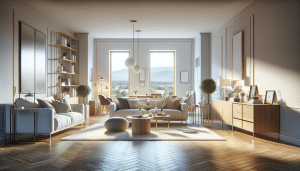Surprising Secrets Behind Cozy Living Spaces
Jessica White October 18, 2025
Explore how to create a home that feels uniquely welcoming and effortlessly stylish. This guide reveals the trending approaches to transforming any living area—including tips on lighting, smart tech, and the psychology of comfort—to help you recharge and connect with what feels good inside your walls.
The Growing Appeal of Cozy Living Spaces
Across the globe, interest in cozy living spaces has soared. Many interior design lovers are seeking ways to make their homes feel both inviting and practical. The cozy living trend isn’t just about aesthetics; it taps into deeper needs for well-being and comfort. With people spending more time indoors, factors such as soft lighting, natural materials, and warm colors are making a notable impact on how rooms feel. This shift is also mirrored in rising search volumes for phrases like “cozy home ideas” and “how to make a room feel warm.” The online buzz shows that more households are curious about layering textures, choosing plush throws, and integrating calming earth tones that instantly make any environment feel soothing.
Many homeowners are drawn to the concept of coziness because it shapes daily experiences. Experts suggest that a well-designed, cozy space can reduce stress and improve mood. Beyond mere decoration, it’s the environment itself—how furniture is arranged, the flow of natural light, and ambient scent—that determines its inviting spirit. Some adopt minimalist Scandinavian concepts, while others embrace a maximalist, layered look. Even rental residents or those on a tight budget often find affordable ways to create comfort, such as using removable wallpaper, large area rugs, or strategic lighting. These choices can turn stark rooms into spaces that stimulate rest and togetherness. Cozy living proves less about following strict styles, more about personal comfort and psychological sanctuary.
The appeal extends even further when considering multi-use spaces. Work-from-home setups now blend productivity with coziness, balancing ergonomic desks and office chairs with softer accents. Research shows that a well-planned cozy corner encourages creativity and focus while offsetting digital fatigue (https://www.ncbi.nlm.nih.gov/pmc/articles/PMC6020053/). Families and roommates are also using cozy design to foster communication and relaxation. Whether you live in a studio apartment or a sprawling house, the move toward inviting, intimate interiors is more than a fad—it’s a cultural shift that supports emotional balance and mindful living.
Lighting: The Essential Ingredient for Ambience
Lighting choices shape the atmosphere in any living environment. The right illumination can make a living room glow softly or set a dynamic energy for hosting. Warm, diffused lamps are proven mood boosters, while harsh overhead bulbs can leave spaces feeling flat or cold. As people experiment with string lights, LED strips, and even candle-like options, lighting innovations offer creative flexibility without major expense. With plug-and-play fixtures and dimmable bulbs, homeowners gain total control over their environment. Highlights directed at cozy reading nooks, wall art, or shelving can also draw focus and contribute to a layered, welcoming feel.
Natural light also plays a vital role. Large windows and reflective surfaces, such as strategically placed mirrors, maximize daylight and open up smaller rooms visually. Sheer curtains allow sunlight to filter in gently while maintaining privacy. According to interior specialists, even in urban settings with less outdoor visibility, carefully managed window light helps maintain circadian rhythm and overall wellness (https://www.ncbi.nlm.nih.gov/pmc/articles/PMC5372984/). For evenings, soft bedside lamps or under-cabinet kitchen lights can extend a cozy ambiance throughout the night, turning harsh lighting into a softer mood-supporting glow.
Technological advances have brought smart lighting systems into the mainstream. Voice-controlled bulbs or programmable scenes allow single rooms to shift from bright productivity to intimate relaxation with a simple command. This integration of tech with lifestyle demonstrates how lighting does more than illuminate; it enhances comfort layered into every corner. Those seeking efficiency can also find options with high energy ratings, meaning creating warm, inviting spaces doesn’t have to compromise sustainability or utility bills.
Textiles, Texture, and the Psychology of Touch
Layering textiles such as blankets, pillows, and rugs can transform how a room feels. The sense of touch evokes immediate comfort, with soft and plush options leading the trend. Faux fur, chunky knits, or velvet add not just visual warmth but a sense of security. This approach allows residents to personalize spaces affordably, adding tactile interest and color pops even in neutral interiors. Strategic fabric choices, like linen sheets or wool throws, make a subtle difference in temperature and perceived coziness. Research links tactile comfort to relaxation and reduced anxiety, especially in communal living areas (https://www.sciencedirect.com/science/article/pii/S0272494418300131).
Texture adds dimension, breaking up visual monotony. Think woven baskets, embroidered cushions, or braided wall hangings. These elements not only look appealing but invite guests to engage physically with the space. People often combine textiles across seasons, swapping heavier blankets for lighter ones as weather changes. By doing so, interiors stay fresh and relevant while always anchoring back to coziness. Even layering different types of fabrics—a cotton slipcover over a sofa with woolen throws—can create a rich sensory palette, appealing to both sight and touch.
The psychology of touch has deep roots. Studies from wellness centers point out that tactile surfaces can lower stress hormone levels—essential in a world where outside stimuli are often overwhelming (https://greatergood.berkeley.edu/article/item/how_touch_calms_stress_and_promotes_wellbeing). It’s why nursery design advises plenty of soft, touchable elements for infants and why adults crave comfort after busy days. Ultimately, the choice of textiles bridges the gap between emotional comfort and a tangible, everyday luxury.
The Influence of Scent, Sound, and Personalization
Comfort isn’t visual alone. Scent has the power to transport and soothe, subtly influencing feelings of security. Fragrant candles, essential oil diffusers, or simply fresh flowers can shift the mood in any space. Lavender and vanilla often evoke calm, while citrus uplifts energy. Households are increasingly tuning into aromatherapy as part of daily routines, finding scent blends that match their wellness goals. Experts suggest that layering signature scents can help demarcate zones in multi-function spaces—one aroma for the living room, another for bedrooms.
Soundscapes shape experiences as much as visuals. Soft background music, gentle white noise, or an indoor water fountain can mask urban noise and boost tranquility. Smart speakers enable playlists tailored to activities—from energizing mornings to quiet wind-down evenings. Personalizing these elements lets residents create their own oasis, no matter the space’s size or configuration. Sound design, whether through acoustic panels or plush decor that dampens noise, makes a crucial difference for both focus and relaxation (https://www.ncbi.nlm.nih.gov/pmc/articles/PMC4609809/).
Personalization cements the feeling of sanctuary. Photos, art displays, and mementos add familiarity, promoting a sense of belonging. New research highlights the impact of personal artifacts in reducing feelings of anxiety or displacement, especially in shared or transitional housing arrangements (https://www.apa.org/news/press/releases/2015/01/home-sweet-home). The takeaway—scent, sound, and treasured items, woven together, transform residences into emotionally connected environments rather than static showrooms.
Embracing Smart Tech for a Modern Yet Cozy Home
Smart homes aren’t just about convenience. Devices like programmable thermostats, app-controlled speakers, or energy-efficient appliances add comfort while reducing environmental impact. For those wondering how to blend technology with coziness, the trick lies in subtlety. Choose smart tech that disappears into the background—think lamps with built-in dimmers or hidden wireless chargers in side tables. These details weave digital advances into the fabric of daily life.
Automating daily routines supports a more relaxed lifestyle. Smart assistants can play relaxing soundscapes or adjust shades for optimal light. In winter, scheduled heating ensures you walk into a warm home. Such touches mean comfort is always available, tailored to preferences without ongoing effort. A recent survey noted a rise in the number of people controlling home environments from their smartphones or voice assistants, splitting time between work and relaxation effortlessly (https://energy.gov/energysaver/articles/thermostats).
Tech should enhance, not overwhelm. The latest design philosophy recommends integrating devices subtly—hiding cables, matching hardware colors to decor, and programming systems for user-friendliness. As living spaces become smarter, the balance between tradition and innovation grows more important. Ultimately, the modern cozy home offers both connectivity and unplugged comfort, inviting all to slow down and savor each moment.
Sustaining Comfort: Cleanliness and Organization Tips
No matter how thoughtfully styled, clutter can quickly undo feelings of coziness. Strategies such as regular decluttering, hidden storage, and open shelving keep living areas tidy and welcoming. Experts advise setting aside brief periods each week to reset, from fluffing couches to wiping down high-touch surfaces. Organization doesn’t just serve aesthetics—it supports mental clarity and reduces daily stress by erasing visual chaos. According to health research, living in cleaner environments correlates to improved mood and productivity (https://www.cdc.gov/healthyhomes/bytopic/housekeeping.html).
Simple routines can keep shared spaces harmonious. Assigning each member their own storage baskets or cubbies ensures everyone contributes to the order. Rotating seasonal decor gives a sense of change—and prevents surfaces from getting overcrowded. Even in tight apartments, furniture with hidden compartments or vertical shelving maximizes every inch, keeping the overall atmosphere light and spacious. A key tip: regularly donate unused items to create room for meaningful objects, making homes feel cared for and intentional.
Bright, open, and organized interiors maximize both comfort and utility. Fresh air, natural light, and a clean foundation encourage relaxation while reducing seasonal allergens or irritants. Developing a personal cleaning schedule transforms tidying from a burden into a healthy ritual. A maintained home reflects care for oneself and those who visit—a final, essential pillar supporting any cozy lifestyle.
References
1. National Institutes of Health. (2018). The impact of lighting on mood and productivity. Retrieved from https://www.ncbi.nlm.nih.gov/pmc/articles/PMC5372984/
2. The American Psychological Association. (2015). Home sweet home: The impact of personalization on well-being. Retrieved from https://www.apa.org/news/press/releases/2015/01/home-sweet-home
3. U.S. Department of Energy. (n.d.). Guidelines for energy-efficient smart home systems. Retrieved from https://energy.gov/energysaver/articles/thermostats
4. Centers for Disease Control and Prevention. (n.d.). Housekeeping for health and safety. Retrieved from https://www.cdc.gov/healthyhomes/bytopic/housekeeping.html
5. University of California, Berkeley. (n.d.). How touch calms stress and promotes well-being. Retrieved from https://greatergood.berkeley.edu/article/item/how_touch_calms_stress_and_promotes_wellbeing
6. ScienceDirect. (2018). Textiles and human well-being: A tactile study. Retrieved from https://www.sciencedirect.com/science/article/pii/S0272494418300131








